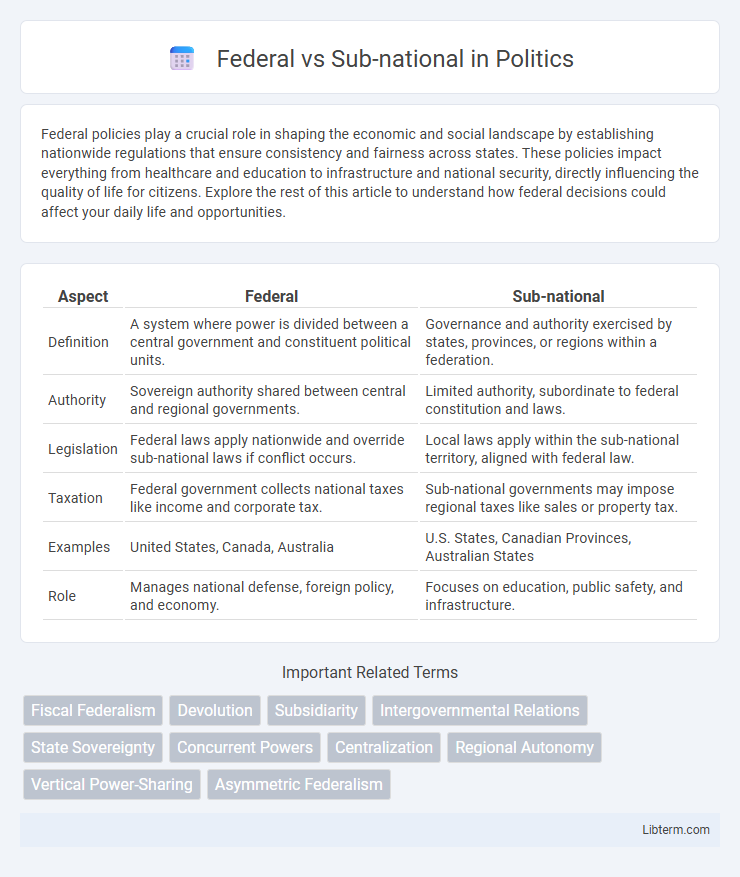Federal policies play a crucial role in shaping the economic and social landscape by establishing nationwide regulations that ensure consistency and fairness across states. These policies impact everything from healthcare and education to infrastructure and national security, directly influencing the quality of life for citizens. Explore the rest of this article to understand how federal decisions could affect your daily life and opportunities.
Table of Comparison
| Aspect | Federal | Sub-national |
|---|---|---|
| Definition | A system where power is divided between a central government and constituent political units. | Governance and authority exercised by states, provinces, or regions within a federation. |
| Authority | Sovereign authority shared between central and regional governments. | Limited authority, subordinate to federal constitution and laws. |
| Legislation | Federal laws apply nationwide and override sub-national laws if conflict occurs. | Local laws apply within the sub-national territory, aligned with federal law. |
| Taxation | Federal government collects national taxes like income and corporate tax. | Sub-national governments may impose regional taxes like sales or property tax. |
| Examples | United States, Canada, Australia | U.S. States, Canadian Provinces, Australian States |
| Role | Manages national defense, foreign policy, and economy. | Focuses on education, public safety, and infrastructure. |
Overview of Federal and Sub-national Systems
Federal systems distribute power between a central government and sub-national entities such as states or provinces, allowing each level to exercise independent authority within designated areas. Sub-national systems pertain to the governance frameworks operating within smaller political units under the national government, often varying in autonomy and administrative functions. This division of power fosters regional representation and accommodates diverse populations within unified national structures.
Key Differences Between Federal and Sub-national Governance
Federal governance divides authority between a central government and multiple sub-national entities such as states or provinces, each possessing constitutional autonomy and legislative powers. Sub-national governance operates within the legal framework established by the federal constitution, with varying degrees of self-rule depending on statutory or constitutional provisions. Key differences include the distribution of legislative, fiscal, and administrative powers, with federal systems ensuring a balance to maintain unity while allowing regional diversity.
Constitutional Frameworks: Federal vs Sub-national Authorities
Federal constitutional frameworks establish a division of powers between the national government and sub-national entities, such as states or provinces, ensuring autonomy within defined competences. Sub-national authorities operate under constitutional provisions granting them legislative, executive, and judicial powers distinct from the central government, enabling governance tailored to local needs. This allocation of authority is typically outlined in a nation's constitution, balancing sovereignty and unity to prevent overlaps and conflicts between federal and sub-national jurisdictions.
Division of Powers and Responsibilities
Federal systems allocate powers between national and sub-national governments through constitutional divisions that delineate exclusive, concurrent, and residual authorities. National governments typically handle defense, foreign affairs, and monetary policy, while sub-national entities manage local education, transportation, and public safety. Clear frameworks for intergovernmental relations and fiscal federalism ensure effective governance and prevent jurisdictional overlaps.
Fiscal Policies: Federal and Sub-national Budgets
Federal budgets control nationwide fiscal policies, managing large-scale public expenditures and revenue collection, including defense, social security, and national infrastructure. Sub-national budgets, managed by states or provinces, focus on regional priorities, such as education, local transportation, and healthcare, with funding often sourced from federal transfers and local taxes. Coordination between federal and sub-national budgets ensures fiscal balance and efficiency in public service delivery across governance levels.
Policy Implementation: Centralization vs Decentralization
Policy implementation in federal systems balances centralization and decentralization, where central governments provide uniform guidelines while sub-national entities adapt policies to local contexts. Centralized implementation ensures national cohesion and consistent standards, but decentralization enhances responsiveness, allowing states or provinces to address unique demographic, economic, and cultural conditions. Effective governance hinges on clear delineation of responsibilities and cooperative mechanisms between federal and sub-national authorities to optimize policy outcomes.
Intergovernmental Relations and Conflicts
In federal systems, intergovernmental relations involve complex interactions between national and sub-national governments, requiring mechanisms to manage overlapping jurisdictions and shared responsibilities. Conflicts often arise from fiscal disparities, legislative overlaps, and policy discrepancies, necessitating negotiation platforms such as intergovernmental councils or judicial arbitration. Effective conflict resolution ensures cooperative governance, preserving the balance of autonomy and unity within the federal structure.
Advantages of Federal Systems
Federal systems enhance governance by allowing regional governments to tailor policies to local preferences, improving administrative efficiency and public satisfaction. They foster political stability through power-sharing, reducing the risk of central government overreach and promoting conflict resolution within diverse societies. This decentralization also encourages innovation by enabling states or provinces to experiment with social and economic reforms before scaling successful models nationally.
Challenges Facing Sub-national Governments
Sub-national governments face significant challenges including limited fiscal autonomy, which restricts their ability to independently raise revenue and allocate budgets effectively. Intergovernmental coordination issues often lead to overlapping responsibilities and inefficiencies in service delivery within federal systems. Additionally, political fragmentation and capacity constraints hinder policy implementation and infrastructure development at the sub-national level.
Impact on Citizens and Local Development
Federal systems distribute authority between national and sub-national governments, enabling localized decision-making that directly addresses citizens' diverse needs and fosters tailored economic growth. Sub-national entities possess autonomy to implement policies reflecting regional priorities, enhancing infrastructure, education, and healthcare services that drive community development. This decentralization promotes citizen participation, accountability, and more efficient resource allocation, resulting in improved quality of life and sustainable local advancement.
Federal Infographic

 libterm.com
libterm.com